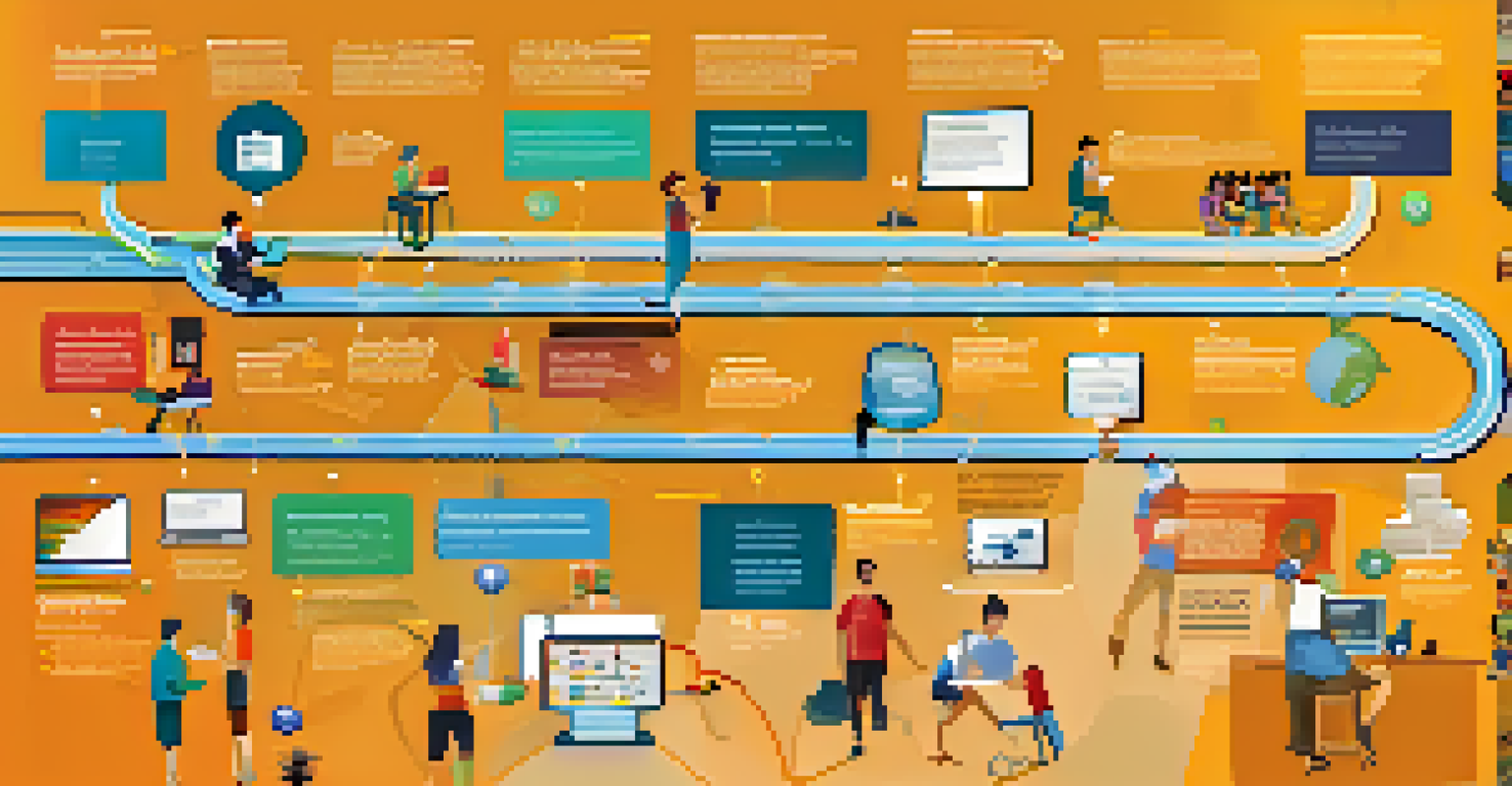The Evolution of Online Learning Platforms in Arizona's Universities

A Brief History of Online Learning in Arizona
Online learning in Arizona began gaining traction in the late 1990s, when universities started exploring digital platforms. Arizona State University (ASU) was among the pioneers, introducing innovative online courses to cater to a growing demand for flexible education. This marked the beginning of a significant shift in how students accessed higher education, paving the way for more institutions to follow suit.
The future of education is not just about technology; it's about how we can use technology to create a more inclusive and engaging learning environment.
As technology advanced, so did the capabilities of these online platforms. By the early 2000s, universities were able to offer a wider range of programs, reaching students who previously faced barriers to traditional education. This evolution was not just about convenience; it was about inclusivity, allowing non-traditional students to pursue their academic goals.
Today, Arizona hosts a diverse array of online learning platforms, each tailored to meet the unique needs of its student population. These platforms continue to evolve, integrating new technologies and teaching methodologies that enhance the online learning experience.
The Role of Technology in Online Learning
Technology has been the backbone of online learning’s evolution in Arizona. With the introduction of learning management systems (LMS) like Blackboard and Canvas, universities have streamlined course management and communication. These platforms allow for interactive learning experiences, making education more engaging and accessible for students.

Moreover, advancements in video conferencing tools have transformed the landscape of online education. Platforms like Zoom and Microsoft Teams have made it possible for instructors and students to connect in real time, fostering a sense of community that mirrors traditional classrooms. This shift has been crucial in maintaining student engagement, especially during the pandemic.
Growth of Online Learning in Arizona
Arizona has seen a significant rise in online learning since the late 1990s, with universities embracing digital platforms to enhance accessibility and flexibility for students.
As we look to the future, emerging technologies such as artificial intelligence (AI) and virtual reality (VR) promise to further enhance the online learning experience. By personalizing education and creating immersive environments, these technologies will likely play a key role in the next phase of online learning in Arizona’s universities.
Impact of the COVID-19 Pandemic on Online Education
The COVID-19 pandemic acted as a catalyst for online learning in Arizona, forcing universities to adapt quickly to remote instruction. Institutions that were previously hesitant to fully embrace online education found themselves implementing digital solutions almost overnight. This rapid shift not only highlighted the importance of flexibility in education but also showcased the resilience of both educators and students.
Education is the most powerful weapon which you can use to change the world.
As a result, many universities enhanced their online offerings, investing in technology and training to ensure a smooth transition for all. The focus shifted to creating high-quality online experiences that could engage students and facilitate learning despite physical distance. This period of adjustment led to valuable lessons about the strengths and weaknesses of online education.
Today, the pandemic's influence continues to shape online learning strategies. Many universities have adopted hybrid models, blending in-person and online instruction, providing students with more options than ever before.
Student Perspectives on Online Learning
Student feedback has been instrumental in shaping the evolution of online learning platforms in Arizona. Many students appreciate the flexibility that online courses offer, allowing them to balance work, family, and education. This flexibility empowers learners to customize their educational journeys, which can lead to higher satisfaction and better outcomes.
However, it’s important to acknowledge that not all students thrive in an online environment. Some miss the face-to-face interaction and support that traditional classrooms provide. Universities have responded by incorporating more collaborative tools and resources, aiming to create a more inclusive online community that addresses various learning styles.
Impact of Technology on Education
Technological advancements, including learning management systems and video conferencing tools, have transformed online education, making it more interactive and community-oriented.
Surveys and focus groups have become valuable tools for universities to gauge student experiences and preferences. This ongoing dialogue between students and educators is crucial for continuously improving online learning platforms and ensuring they meet the needs of all learners.
The Importance of Accessibility in Online Learning
Accessibility is a critical consideration for online learning platforms in Arizona's universities. Ensuring that all students, regardless of their backgrounds or abilities, can access educational resources is paramount. This commitment to inclusivity not only aligns with educational values but also enriches the learning experience for everyone involved.
Many universities have taken significant steps to enhance accessibility by adhering to guidelines such as the Web Content Accessibility Guidelines (WCAG). These guidelines help to create content that is perceivable, operable, and understandable for all users, including those with disabilities. This focus on accessibility fosters an environment where all students can thrive.
As online learning continues to evolve, the push for greater accessibility will remain a priority. By embracing a mindset of inclusivity, Arizona's universities can ensure that their platforms serve as equitable spaces for learning.
Future Trends in Online Learning Platforms
Looking ahead, several trends are poised to shape the future of online learning platforms in Arizona. One of the most notable is the increasing use of personalized learning experiences. By leveraging data analytics, universities can tailor coursework to meet individual student needs, enhancing engagement and comprehension.
Additionally, the incorporation of micro-credentials and shorter, focused courses is gaining traction. This approach allows students to acquire specific skills quickly, making education more responsive to the demands of the job market. As industries evolve, so too must educational offerings, ensuring students are prepared for the future.
Student-Centric Online Learning
Feedback from students has driven the evolution of online platforms, highlighting the need for flexibility, accessibility, and a supportive online community.
Finally, the integration of gamification elements into online courses is becoming more prevalent. By incorporating game-like features, such as rewards and challenges, universities can create more interactive and motivating learning environments. These innovations promise to make online learning not just educational, but also enjoyable.
Conclusion: The Bright Future of Online Learning
The evolution of online learning platforms in Arizona's universities reflects a broader trend in education that values flexibility, accessibility, and innovation. As technology continues to advance, so too will the opportunities for students seeking quality education in a format that suits their lifestyles. The commitment of Arizona's universities to enhancing online learning experiences is a testament to their dedication to student success.
While challenges remain, particularly in ensuring equitable access and maintaining engagement, the progress made thus far is promising. With a focus on continuous improvement and responsiveness to student needs, Arizona's universities are well-positioned to lead in the future of online education.

In summary, the journey of online learning in Arizona is just beginning, and the possibilities are endless. By embracing change and fostering a culture of innovation, these institutions can provide students with the tools they need to thrive in an ever-evolving world.